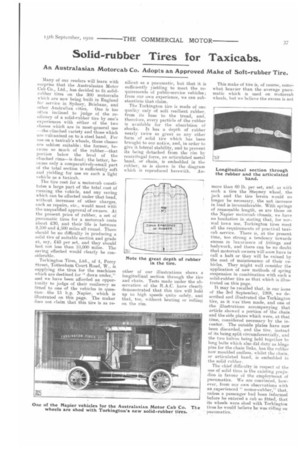Solid-rubber Tires for Taxicabs.
Page 17

If you've noticed an error in this article please click here to report it so we can fix it.
Many of our readers will learn with surprise that the Australasian Motor Cab Co., Ltd., has decided to fit solidrubber tires on the 300 motorcabs which are now being built in England for service in Sydney, Brisbane, and other Australian cities. One is too often inclined to judge of the resiliency of a solid-rubber tire by one's experiences with either of the two classes which are in most-general use --the clinched variety and those which are vulcanized on to a steel band. For use on a taxicab's wheels, these classes are seldom suitable: the former, because so much of the rubber—that portion below the level of the clinched rims—is dead ; the latter, because only a comparatively-small part of the total section is sufficiently soft and yielding for use on such a light vehicle as a taxicab.
The tire cost for a motorcab constitutes a large part of the total cost of running the vehicle, and any saving which can be effected under that head, without increases of other charges, such as repairs, etc., would meet with the unqualified approval of owners. At the present price of rubber, a set of pneumatic tires for a motorcub costs about £30, and their life is between 3,500 and 4,500 miles all round. There should be no difficulty in producing a solid tire of suitable section and grade at, say, £45 per set, and they should last not less than 10,000 miles. The saving effected would clearly be considerable.
Torkington Tires, Ltd., of 4, Percy Street, Tottenham Court Road, W., is supplying the tires for the machines which are destined for " down under," and we have been afforded an opportunityto judge of their resiliency as fitted to one of the vehicles in question-the 15 h.p. Napier, which is illustrated on this page. The maker does not claim that this tire is as re
silient as a pneumatic, but that it is sufficiently yielding to meet the requirements uf public-service vehicles ; from our own experience, we can substantiate that claim.
The Torkington tire is made of one quality only of soft resilient rubber. from its base to the tread, and, therefore, every particle of the rubber is available for the absorbtion of shocks. It has a depth of rubber nearly twice as great as any other form of solid tire which has been brought to our notice, and, in order to give it lateral stability, and to prevent its being detached from the rim by centrifugal force, an articulated metal band, or chain, is embedded in the rubber, as is shown in the diagram which is reproduced herewith. An other of our illustrations shows a longitudinal section through the tire and chain. Tests made under the observation of the R.A.C. have clearly demonstrated that this tire will hold up to high speeds quite safely, and that, too, without heating or rolling on the rim. This make of tire is, of course, somewhat heavier than the average pneumatic which is used on motoreab wheels, but we believe the excess is not
more than 60 lb. per set, and, as with such a tire the Stepney wheel, the jack and the tire levers would no longer be necessary, the net increase in load is inconsiderable. With springs of reasonable length, as are those on the Napier motorcab chassis, we have no hesitation in stating that, for normal town use, Torkington tires meet all the requirements of practical taxicab service. There is, at the present time, too strong a tendency towards excess in luxuriance of fittings and bodywork, and there can be no doubt that motorcab owners will soon have to call a halt or they will be ruined by the cost of maintenance of their vehicles. They might well consider the application of new methods of spring suspension in combination with such a solid-rubber tire as that which is illustrated on this page.
It may be recalled that, in our issue of the 3rd September, 1908, we described and illustrated the Torkington tire, as it was then made, and one of the illustrations accompanying that article showed a portion of the chain and the side plates which were, at that time, considered necessary by the inventor. The outside plates have now been discarded, and the tire, instead of its being split circumferentially, and the two halves being held together by long bolts which also did duty as hinge pins for the chain links, has the rubber now monlded endless, whilst the chain, or articulated band, is embedded in the solid rubber.
The chief difficulty in respect of the use of solid tires is the existing prejudice in favour of the employment of pneumatics. We are convinced, however, from our own observations with an experienced " inotor-eabber," that, unless a passenger had been informed before he entered a cab so fitted, that its wheels were shod with Torkingtoa tires he would believe he -was riding es
pneumatics. •
























